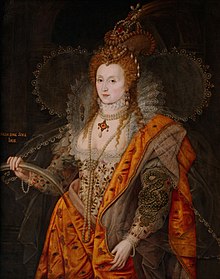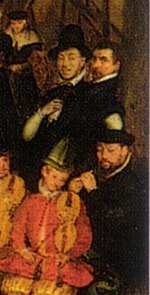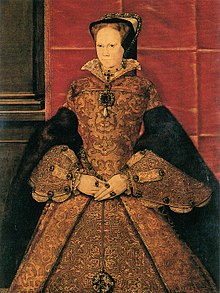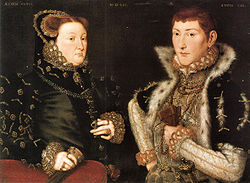Artists of the Tudor court

The artists of the Tudor court are the
Typically managing a group of assistants and
Although there were English artists throughout the period, many artists were foreigners, especially from the Low Countries, but also from Italy and Germany. Some only stayed for short periods, but many for several years or the rest of their lives.
Isolation and iconography

The Tudor period was one of unusual isolation from European trends for England. At the start the

With the virtual extinction of religious painting at the
Much energy was also expended on decorative painting of fixtures and fittings, often of a very temporary nature. In theory the "
Jewellery and metalwork were regarded as extremely important, and far more was spent on them than on painting. Holbein produced many spectacular designs for now-vanished table ornaments in precious metals, and Hilliard was also a practising goldsmith. The main artistic interests of Henry VIII were music, building palaces and tapestry, of which he had over 2,000 pieces, costing far more than he ever spent on painters. The Flemish set with the Story of Abraham still at Hampton Court Palace is one grand set from late in his reign.

Elizabeth spent far less, hardly building anything herself, but took a personal interest in painting, keeping her own collection of miniatures locked away, wrapped in paper on which she wrote the names of the sitter. She is reputed to have had paintings of her burnt that did not match the iconic image she wished to be shown.
The most progressive and spectacular palace of the Tudor period,
Community of artists

Many of the artists active at the Tudor court were connected by ties of family, marriage, and training.
Lucas and Susanna Horenbout's father,
Residents

- Meynnart Wewyck (Maynard Vewicke), resident ca. 1502–1525, painter of "pictours" or panel portraits to both Henry VII and Henry VII.[14]
- Lucas Horenbout, pioneer of the portrait miniature, King's Painter from 1531 until his death in 1544.
- Anthony Toto and Bartolommeo Penni.
- Hans Holbein the Younger, spent many years on two visits, painting the best portraits of the Tudor period.
- Levina Teerlinc, miniaturist and lady-in-waiting.
- John Bettes the Elder, engaged for decorative work at Whitehall from 1531 to 1533; also a portrait-painter and miniaturist.[15]
- Gerlach Flicke, or "Garlicke" in some English records, German portraitist, in London from c. 1545 until his death in 1558.
- Hans Eworth, in England from c. 1549; portrait-painter and recorded as a designer for the Office of the Revels.
- Steven van Herwijck, portrait medallist, visited 1562, resident 1565 until his death in 1567.
- Steven van der Meulen, arrived by 1561, naturalized 1562, active until his death in 1563.[16]
- Marcus Gheeraerts the Younger, Flemish Protestant refugee portraitist, who arrived as a child.
- George Gower, English portraitist.[d]
- Nicholas Hilliard, miniaturist and goldsmith to Elizabeth I from c. 1572.
- Hieronimo Custodis, Flemish exile portraitist active from 1589 until his death in 1593.
- Sir William Segar, portraitist and herald; later Garter Principal King of Arms 1607–1633.
- John de Critz the Elder, arrived from Flanders as a child, portraitist.
- Robert Peake the Elder, English portraitist; also employed by the Office of the Revels; later serjeant painter under James I.
- Isaac Oliver, Hilliard's pupil and later rival.
- Rowland Lockey, another apprentice of Hilliard.
Visitors

- Pietro Torrigiano, Florentine sculptor, on the run after breaking Michelangelo's nose, made Henry VII's tomb and other monuments in an extended stay. With Mazzoni, a rare portrait sculptor at the Tudor court.
- Possibly Guido Mazzoni, Florentine sculptor mostly in painted terracotta. He submitted alternative designs for Henry's tomb, and a painted terracotta bust by him may be of Henry VIII as a boy.[e]
- Michael Sittow probably painted Henry VII and a picture of Catherine of Aragon for her mother, his employer
- Possibly the Venetian Antonio Solario, who certainly painted an altarpiece for a London merchant in 1514
- Girolamo da Treviso, hired mainly as a military engineer (who died in action), but also left a significant painting
- Fontainebleau for Nonsuch Palace
- Lucas Cornelisz. de Cock[f](1495–1552) Dutch portrait and history painter, probably in England c. 1527–1532, before leaving for Italy
- William or Guillim Scrots, employed by Henry VIII from at least 1545 and retained by Edward VI until the king died in 1553
- Habsburg portraitist, visited with Philip II of Spain
- Marcus Gheeraerts the Elder a Flemish Protestant refugee, stayed nine years, and returned in 1585 until his death sometime before 1589 [17]
- Quentin Metsys the Younger or Massys
- Cornelius Ketel stayed eight years, painting histories and portraits
- Lucas de Heere Protestant refugee who returned to Flanders after ten years, when it was safe to do so
- Joris Hoefnagel, in England c. 1569–71 making drawings for Civitates Orbis Terrarum; painted A Fête at Bermondsey while in England
- Federico Zuccari visited for six months, painting Elizabeth and Leicester
Serjeant Painters

The holders of the office were:[20]
- John Browne, heraldic painter since 1502, appointed "King's Painter" in 1511/12, and as the first Serjeant Painter in 1527, when the imported artist Lucas Horenbout took over as "King's Painter" - now the superior position. Browne died in office in December 1532.
- Andrew Wright, 1532–1544, about whom little is known
- "Cardinal Wolsey, as they first appear in the accounts just after Wolsey's fall in October 1529. "Toto" had been signed on in Florence in 1519 as an assistant to Pietro Torrigiano, who in fact left England for good later that year. Toto and Penni spent most of their time after 1538 working on Nonsuch Palace, including elaborate stucco work for Henry's most advanced building, now vanished.
- Nicolas Lizard (or Lisory), a French artist, held the post from 1554 to his death in 1571[22]
- William Herne or Heron, 1572 to 1580[22]
- George Gower 1581 until his death in 1596
- Leonard Fryer 1596–1607, about whom very little is known, joined after the death of Elizabeth by
- John de Critz the Elder from 1603.
Identification and attribution

Many surviving images have been badly worn over the years, or incompetently "restored". Inscriptions are often later than the paintings themselves, and may reflect wishful thinking; many anonymous Tudor ladies were identified as "Mary I", or, especially, one or other of Henry VIII's queens, by the owners of pictures. Anne Boleyn in particular has been said to be the subject of dozens of pictures; even now there is no certain image of her done from life, and the most plausible,[23] is a later copy and among the least informative. The only probable portrait of Catherine Howard, a miniature by Holbein in the Royal Collection, is only identified by circumstantial evidence (see Gallery).[24][g]
A well-known painting (left) was identified by
Attribution to artists is even more challenging; not all artists signed their work, and those who did may not have done so consistently. Many pictures have been cut down, extended, or otherwise altered in ways that damage or destroy inscriptions. Artists' workshops often churned out copies of the master's work to meet the demand for portraits, as symbols of devotion to the Crown or simply to populate the fashionable "long galleries" lined with portraits.
Today, attributions are made on the basis of style, sitter, accepted date, and related documentation such as receipts or bills for payment and inventories of collections or estates. It is now generally accepted that the artist known as "The Monogrammist HE" is Hans Eworth,[26] but other identifications remain elusive. Some of the most well-known images of the period, such as the portrait of Elizabeth I when a Princess, age 13, have been attributed to many artists over the years, but remain cautiously labelled "?Flemish School" in recent catalogues.[27] Much scholarly debate also circles around identification of possible portraits of Lady Jane Grey.[h]
Payments
The royal accounts for the period survive, but are not always easy to interpret. Payments often covered expensive materials, and in many cases the wages of assistants had to be paid out of them. Some regular annuities, usually supplemented by payments for specific works, are given below. But recipients were expected to give works to the monarch, at New Year or on their birthday.
Royal annuities:
- Meynnart Wewyck (as "olde maynerd wewoke paynter"), half-yearly payment of 100 shillings in 1525[28]
- Lucas Hornebolte (scholarly dissention) £33 6s[29] or £62 10s from 1525 "until his death"[30]
- Hans Holbein £30 (but he did more work outside the court)[31]
- Levina Teerlinc £40[32]
- Nicholas Hilliard received £400 as a gift in 1591, and an annuity of £40 from 1599;[33] he typically charged £3 for a non-royal miniature.
The sums spent on metalwork, building palaces, and by Henry on tapestries, dwarfed these figures.
Galleries
Miniatures
-
Lucas Horenbout, Manuscript portrait of Henry VIII, 1525–26
-
Holbein, Catherine Howard c. 1540; probably the only image of her from life - see text.
-
Attributed toMaundy, c. 1560
-
Nicholas Hilliard, Young Man Amongst Roses c. 1588
Preparatory drawings
-
Sketch of Lady Elyot by Holbein in chalk, pen and brush on paper, 1532–33, Royal Collection, Windsor
-
Companion sketch ofSir Thomas Elyot by Holbein, Royal Collection, Windsor. Neither portrait has survived.
-
Preliminary chalk sketch for a portrait of Elizabeth I by Federico Zuccari, 1570s, which has not survived.
Panel paintings
-
Christina of Denmark in mourning, 1538. A prospective bride for Henry VIII, who Holbein was sent to portray.
-
Mary I byAnthonis Mor, c. 1541
-
Elizabeth I as a Princess, formerly attributed to William Scrots, c. 1546
-
Margaret Audley, Duchess of Norfolk, 1562, companion to portrait of the Duke, by Hans Eworth
-
Portrait of Lady Kitson by George Gower, 1573
-
The Earl of Essex in tilting armor by William Segar, 1590
Paintings on canvas
-
Henry VIII after a Holbein of 1537. Later copy by unknown artist afterWhitehall Palace.[i]
-
The Ditchley Portrait of Elizabeth by Marcus Gheeraerts the Younger, 1592
Notes
- ^ The Grimston on loan. Grimston was a Lancastrian, or at least Henry VI of England's agent before the Wars of the Roses began, Donne a Yorkist.
- ^ Strong 1969 suggests that Hoefnagel and fellow Flemish exiles are sitting beneath the tree. Town 2015 reattributes the painting to Gheeraerts the Elder, but the figures may represent him and his circle.
- ^ Karel van Mander says Holbein was taught the art by a "Master Lucas", and there is a miniature of Holbein by Horenbout.[10]
- ^ A major reassessment of Gower's career as a portraitist was published in The Burlington Magazine in September 2020 (Town 2020).
- ^ Royal Collection. Mazzoni was working on the tomb of Charles VIII of France in Paris, and may have made a visit in connection with the tomb.
- ^ His names are confusing. His father was the painter Cornelis Engebrechtsz. ("z." = "zoon" or son of). He is known as Lucas Cornelis Engebrechtsz., Lucas Cornelis de Kok, Lucas Cornelis Kunst, and several variants and permutations, even before contemporary English and Italian attempts are involved. Getty Union Name List. He is mentioned by Karel van Mander.
- ^ Strong is persuaded for various reasons: two Holbein versions exist (Royal Collection, Windsor & Duke of Buccleuch), which is only known for queens among female sitters for Tudor miniatures; she wears the same jewel as Jane Seymour in the Vienna Holbein (shown above); the pearls may tie in with a gift to Catherine from Henry in 1540, and she is the only Queen to fit. There are no other plausible likenesses of her to compare to. Both versions have long been known as of Catherine Howard. This is the Windsor version, considered the original done from life.
- ^ See "Is this the true face of Lady Jane?" - article from The Guardian, 16 January 2006, describing a portrait (found in a South London home) that purportedly depicts Lady Jane Grey, and discussion of two portraits identified in 2005 as depicting Lady Jane at SomeGreyMatter.
- ^ a full copy The original cartoon, slightly different in pose, also survives (National Portrait Gallery, London), but no original Holbein version of this iconic image does. See Holbein and the Court of Henry VIII, 122-5.
References
Citations
- ^ Strong 1987, p. 50–52
- ^ Strong 2019, p. 189
- ^ Hearn 2002, p. 34
- ^ Hearn (2001), which mainly deals with the Jacobean court
- ^ Holbein and the Court of Henry VIII, pp. 11, 16; 1978, The Queen's Gallery, Buckingham Palace
- ^ Strong 1983
- ^ Strong 1987
- ^ JSTOR Burlington Magazine, The Stuccos of Nonsuch by Martin Biddle
- ^ British Archaeology, Sutton - views of interior Archived June 22, 2008, at the Wayback Machine
- ^ Strong 1981, p. 37.
- ^ Strong 1981, p. 30-31
- ^ Strong 1981, p. 41
- ^ a b Hearn, p. 130
- ^ Kipling 1982, p. 135-136/
- ^ Hearn, p. 46
- ^ Town (2014), p. 179-181
- ^ Town 2015, p. 313
- ^ Hearn, p. 107
- ^ Strong 1969
- ^ Details for all, unless otherwise stated, from Ellis Waterhouse, "Painting in Britain, 1530–1790", 4th Edn, 1978, Penguin Books (now Yale History of Art series) - see Serjeant Painter in Index
- ^ Getty biography of Luca
- ^ a b Waterhouse, p. 27
- ^ according to Strong 1969
- ^ Strong (1983):50
- ^ Based on the ages of sitters and a ring worn by Mary Nevill; see Hearn, p. 68; see also Honig, "In Memory: Lady Dacre and Pairing by Hans Eworth" in Renaissance Bodies: The Human Figure in English Culture c. 1540–1660.
- ^ Hearn, p. 63
- ^ Hearn, p. 78
- ^ Foister, Susan. (2003). "Vewicke [Waywike; Wewoke], Maynard." Oxford Art Online. Retrieved 7 Apr. 2019, from http://www.oxfordartonline.com/view/10.1093/gao/9781884446054.001.0001/oao-9781884446054-e-7000089182.
- ISBN 1-903973-28-7
- ^ Strong (1983):34
- ^ Kren, 434.
- ^ Strong (1983):52
- ^ Strong (1983):72
- ^ Nairne, Sandy. "Case study 4 – new research on the Gallery's earliest portrait: Henry VII". Making Art in Tudor Britain. National Portrait Gallery. Retrieved 29 May 2009.
Sources
- Hearn, Karen, ed. Dynasties: Painting in Tudor and Jacobean England 1530–1630. New York: Rizzoli, 1995. ISBN 0-8478-1940-X(Hearn 1995)
- Hearn, Karen: Insiders or outsiders? Foreign-born artists at the Jacobean court, in From strangers to citizens: the integration of immigrant communities in Britain, Ireland, and colonial America, 1550–1750, ed. Randolph Vigne, Charles Littleton, Huguenot Society of Great Britain and Ireland, Sussex Academic Press, 2001, (Hearn 2001)
- Hearn, Karen: Marcus Gheeraerts II : Elizabethan artist. London: Tate Publications. OCLC 51529012. (Hearn 2002)
- Holbein and the Court of Henry VIII : the Queen's Gallery, Buckingham Palace, 1978–1979. London: Queen's Gallery, 1979.
- Honig, Elizabeth: "In Memory: Lady Dacre and Pairing by Hans Eworth" in Renaissance Bodies: The Human Figure in English Culture c. 1540–1660 edited by Lucy Gent and Nigel Llewellyn, Reaktion Books, 1990, ISBN 0-948462-08-6
- Kinney, Arthur F.: Nicholas Hilliard's "Art of Limning", Northeastern University Press, 1983, ISBN 0-930350-31-6
- Kipling, Gordon: "Henry VII and the Origins of Tudor Patronage" in Patronage in the Renaissance edited by Guy Fitch Lytle and Stephen Orgel, Princeton: Princeton University Press, 1982 OCLC 938371639(published online 2016). Retrieved 8 April 2019.
- Reynolds, Graham: Nicholas Hilliard & Isaac Oliver, Her Majesty's Stationery Office, 1971
- Strong, Roy,The English Icon: Elizabethan and Jacobean Portraiture, 1969, Routledge & Kegan Paul, London (Strong 1969)
- Strong, Roy: Nicholas Hilliard, 1975, Michael Joseph Ltd, London, ISBN 0-7181-1301-2(Strong 1975)
- Strong, Roy: The Cult of Elizabeth, 1977, Thames and Hudson, London, ISBN 0-500-23263-6(Strong 1977)
- Strong, Roy: Artists of the Tudor Court: The Portrait Miniature Rediscovered 1520–1620, Victoria & Albert Museum exhibit catalogue, 1983, ISBN 0-905209-34-6(Strong 1983)
- Strong, Roy: "From Manuscript to Miniature" in John Murdoch, Jim Murrell, Patrick J. Noon & Roy Strong, The English Miniature, Yale University Press, New Haven and London, 1981 (Strong 1981)
- Strong, Roy: Gloriana: The Portraits of Queen Elizabeth I, Thames and Hudson, 1987, ISBN 0-500-25098-7(Strong 1987)
- Strong, Roy:. The Elizabethan image : an introduction to English portraiture, 1558 to 1603. New Haven. OCLC 1055255018. (Strong 2019)
- Town, Edward: "A Biographical Dictionary of London Painters, 1547–1625". The Volume of the Walpole Society, 2014, 76: 1–235. JSTOR 24855803(Town 2014)
- Town, Edward: "'A fête at Bermondsey': an English landscape by Marcus Gheeraerts the Elder", The Burlington Magazine, May 2015, 157 (1346): 309-317 (Town 2015)
- Town, Edward; David, Jessica: "George Gower: portraitist, Mercer, Serjeant Painter". The Burlington Magazine, 2020, 162 (1410): 731–747. (Town 2020)
- Waterhouse, Ellis: Painting in Britain, 1530–1790, 4th Edn, 1978, Penguin Books (now Yale History of Art series)








![Henry VII no longer thought to be by Michael Sittow, c. 1505.[34]](http://upload.wikimedia.org/wikipedia/commons/thumb/9/9b/Henry_Seven_England.jpg/97px-Henry_Seven_England.jpg)








![Henry VIII after a Holbein of 1537. Later copy by unknown artist after Hans Holbein the Younger's destroyed mural at Whitehall Palace.[i]](http://upload.wikimedia.org/wikipedia/commons/thumb/5/57/Holbein_henry8_full_length.jpg/67px-Holbein_henry8_full_length.jpg)
